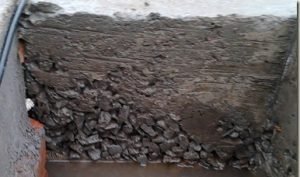Factors Affecting Failures in Concrete Structure

Factors Affecting Failures in Concrete Structure
Failures in concrete structures can be due to any of the following factors:
1. incorrect selection of materials
2. errors in design calculations and detailing
3. poor construction methods and inadequate quality control and supervision
4. chemical attack
5. external physical and/or mechanical factors including alterations made to the structure
The above items failures in concrete structure are discussed in more detail below.
Incorrect Selection of Materials
The concrete mix required should be selected to meet the environmental or soil conditions where the concrete is to be placed. The minimum grade that should be used for reinforced concrete is grade 30. Higher grades should be used for some foundations and for structures near the sea or in an aggressive industrial environment. If sulphates are present in the soil or ground water, sulphate-resisting Portland cement should be used. Where freezing and thawing occurs air entrainment should be adopted. Further aspects of materials selection are discussed below.
Errors in Design Calculations and Detailing
An independent check should be made of all design calculations to ensure that the section sizes, slab thickness etc. and reinforcement sizes and spacing specified are adequate to carry the worst combination of design loads. The check should include overall stability,robustness and serviceability and foundation design.
Incorrect detailing is one of the commonest causes of failure and cracking in concrete structures. First the overall arrangement of the structure should be correct, efficient and robust. Movement joints should be provided where required to reduce or eliminate cracking. The overall detail should be such as to shed water.
Internal or element detailing must comply with the code requirements. The provisions specify the cover to reinforcement, minimum thicknesses for fire resistance, maximum and minimum steel areas, bar spacing limits and reinforcement to control cracking, lap lengths, anchorage of bars etc.
Poor Construction Methods
The main items that come under the heading of poor construction methods resulting from bad workmanship and inadequate quality control and supervision are as follows.The Following guidance on many of the aspects Failures in Concrete Structure discussed below.
(a) Incorrect placement of steel
Incorrect placement of steel can result in insufficient cover, leading to corrosion of the reinforcement. If the bars are placed grossly out of position or in the wrong position, collapse can occur when the element is fully loaded.
(b) Inadequate cover to reinforcement
Inadequate cover to reinforcement permits ingress of moisture, gases and other substances and leads to corrosion of the reinforcement and cracking and spalling of the concrete.
(c) Incorrectly made construction joints
The main faults in construction joints are lack of preparation and poor compaction.The old concrete should be washed and a layer of rich concrete laid before pouring is continued. Poor joints allow ingress of moisture and staining of the concrete face.
(d) Grout leakage
Grout leakage occurs where formwork joints do not fit together properly. The result is a porous area of concrete that has little or no cement and fine aggregate. All formwork joints should be properly sealed.
(e) Poor compaction
If concrete is not properly compacted by ramming or vibration, the result is a portion of porous honeycomb concrete. This part must be hacked out and recast. Complete compaction is essential to give a dense, impermeable concrete.
(f) Segregation
Segregation occurs when the mix ingredients become separated. It is the result of
1. dropping the mix through too great a height in placing. Chutes or pipes should be used in such cases.
2. using a harsh mix with high coarse aggregate content
3. large aggregate sinking due to over-vibration or use of too much plasticizer Segregation results in uneven concrete texture, or porous concrete in some cases.
More info Causes and Prevention of Segregation

(g) Poor curing
A poor curing procedure can result in loss of water through evaporation. This can cause a reduction in strength if there is not sufficient water for complete hydration of the cement.Loss of water can cause shrinkage cracking. During curing the concrete should be kept damp and covered.
(h) Too high a water content
Excess water increases workability but decreases the strength and increases the porosity and permeability of the hardened concrete, which can lead to corrosion of the reinforcement. The correct water-to-cement ratio for the mix should be strictly enforced.
Civil Engineering Books Available here








